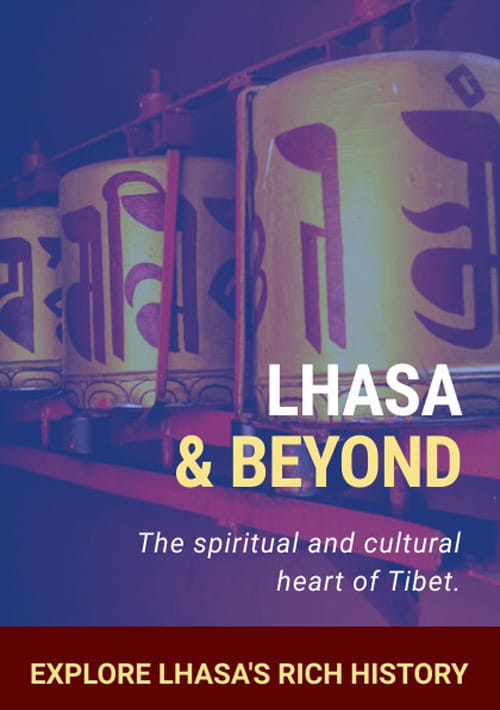
Trip to Lhasa is an experience of a lifetime, spiritual and scenic. Our Lhasa tour packages allow you to visit Potala Palace, Jokhang Temple and Barkhor Street and get into the heart of Tibetan culture. With many options to choose from, each Lhasa tour is designed to give you insights into local customs and Tibetan Buddhism, perfect for adventure seekers and spiritual wanderers. Use this Lhasa travel guide to find out when to go, tips and must see places so you can have a smooth and meaningful journey in the “City of Gods.”
Lhasa, the holy heart of Tibet, is a fascinating place where old traditions, stunning landscapes and rich Buddhist culture meet. Known as the “City of the Gods”, Lhasa is home to Potala Palace and Jokhang Temple, attracting travelers from all over the world. This Lhasa travel guide has tips, must see places and cultural insights to help you make the most of your trip. Whether you are looking for Lhasa tour packages or planning a independent trip, this guide has everything you need for a wonderful journey.
Before you get to Lhasa, preparation is key to a smooth and meaningful journey. Here are a few travel tips to help you make the most of your time in Tibet’s capital:
Lhasa has many historical and spiritual sites. Here are the top places to include in your Lhasa itinerary:
Lhasa’s culture is deeply rooted in Tibetan Buddhism and it’s visible everywhere. From early morning prayers to ritual circumambulations, Tibetan customs are all around. Here are a few cultural insights to help you make the most of your visit:
Lhasa tours have many options, from spiritual tours focused on monasteries and temples to adventure tours that explore the natural scenery. When choosing a tour, think what you want to focus on, whether it’s Tibetan culture, high altitude trekking or historical sites.
The best time to take Lhasa tours is from April to October when the weather is mild and good for sightseeing. If you want to experience Tibetan festivals, visiting in February or March to see Losar can add a cultural layer to your trip.
A trip to Lhasa is like no other, with spiritual depth, breathtaking scenery and warm local people. With this Lhasa guide, you are ready to go on a meaningful and unforgettable trip. Check rules and regulations with government Tibet autonomous region before travel to Lhasa
Lhasa, the spiritual center of Tibet, can be reached by several means of transport, making it easier for travelers to visit this destination. Whether you are booking a Lhasa tour or traveling independently, here’s all you need to know to get to Lhasa.
By Air
Lhasa’s Gonggar Airport (LXA) is the main international airport, located 62km from the city center. It connects Lhasa to major Chinese cities, including Beijing, Chengdu and Xi’an. Lhasa to Kathmandu is the only international flight. If you are booking a Lhasa tour, you can ask your Tibet tour operator to include the flight as part of the tour itinerary, it’s a convenient and efficient way to get to Lhasa.
By Train
Lhasa Railway Station connects Tibet to the rest of China through the Qinghai-Tibet Railway, a scenic route like no other. The journey takes you through some of the highest train routes in the world, crossing vast Tibetan plateaus and stunning scenery. If you are booking a Lhasa tour, many tours offer train travel as an option, especially for those who want an adventurous way to get to Lhasa.
By Road
For the brave, traveling to Lhasa by road is an option, but it requires careful planning. The journey starts from Chengdu or Xining, with several long distance buses running along this route. However, this is not recommended for inexperienced travelers as high altitude can be challenging. Many Lhasa tours do not include this option as the terrain and altitude risk is high.
Getting to Lhasa via the Kyirong border is also a popular route for travelers entering Tibet from Nepal. Kyirong is 150km from Lhasa and is a scenic and accessible entry point, especially for those coming from Kathmandu. The border is well connected by road and travelers usually take jeep or bus to get to Lhasa. This route allows you to experience the Tibetan plateau scenery while acclimatizing gradually to the altitude. Make sure you have the Tibet Travel Permit, which can be arranged by an authorized Tibet tour operator before your departure. The journey from Kyirong to Lhasa takes 2-3 days and passes through villages and monasteries along the way.
Tibet Holiday is a premier Tibet travel agency offering personalized tours to explore the rich culture and stunning landscapes of Tibet. With nearly 20 years of experience, our dedicated team of local experts provides unique insights into Tibetan traditions and spiritual sites. Committed to sustainable travel, we collaborate with local businesses, ensuring an authentic and enriching experience. Whether seeking adventure or cultural exploration, Tibet Holiday designs custom journeys tailored to your interests, making it a trusted choice for unforgettable Tibet experiences.